Teacher Update Bridging the Textbook Gaps on How the RBA Implements a Change to the Cash Rate
One of the most commonly asked questions by educators has been about how the Reserve Bank of Australia (RBA) implements monetary policy. In particular, they are interested in understanding how closely the actual process of monetary policy implementation matches the typical textbook explanation. Practice differs from theory and there are some gaps in the explanations provided by the typical textbook. This article aims to bridge these gaps by providing a stylised but more comprehensive explanation of the process. It will also describe how the introduction of unconventional monetary policy tools following the onset of the COVID-19 recession has affected the process.
Background
The RBA, the nation's central bank, is responsible for setting and implementing monetary policy in Australia. The primary and conventional tool for monetary policy is the nation's policy interest rate (known as the cash rate). The Reserve Bank Board sets the target for the cash rate in the Australian cash market – the market in which banks lend to and borrow money from each other overnight. Changes in the cash rate then flow through to other interest rates in the economy, influencing economic activity and ultimately inflation.[1]
It is commonly described in textbooks that a policy interest rate is managed by a nation's central bank through the use of open market operations (OMOs).[2] These operations involve the central bank buying and selling bonds (typically government bonds) to inject cash into and withdraw cash from the financial system to influence the cash rate.
In Australia's case, this is true – but in practice there is more to the story. Essentially, prior to the COVID- 19 recession, OMOs were typically used to manage the supply of cash (or liquidity) so that the RBA could meet demand and ensure that the cash rate remained consistent with the target the Board set as part of their monetary policy decision. This was done on a daily basis - regardless of whether there was a change to the cash rate target - and was often referred to as ‘liquidity management’. However, when the RBA did change the target for the cash rate, this was achieved by shifting something known as the ‘policy interest rate corridor’.
This article reconciles how the RBA has typically managed the cash rate in the past with standard textbook descriptions. It will explain the workings of the policy interest rate corridor and the use of OMOs to manage the supply of cash (liquidity) to keep the cash rate within this corridor and at target. It then describes how the RBA's policy actions following the onset of the COVID-19 recession has affected this process.
Some Things You Need To Know
The functioning of the Australian cash market
The Australian cash market is the market for overnight loans between banks. The interest rate in this market is called the cash rate.
After each meeting of the Reserve Bank Board, a target is set for the cash rate as part of the Board's monetary policy decision. Before the onset of the COVID-19 recession, the RBA's Domestic Markets Department was tasked with maintaining conditions in the Australian cash market to ensure that the cash rate target was achieved. This was done on a daily basis by managing the supply of cash. In the context of the Australian cash market, ‘cash’ refers to the Exchange Settlement (ES) balances that banks hold in ES accounts with the RBA in order to make payments to each other and the RBA.[3]
There are four key aspects of the Australian cash market that are commonly referred to by standard textbooks when describing the management of the cash rate:
- Price – the interest rate in the Australian cash market for overnight loans, known as the cash rate.
- Quantity – the quantity of ES balances (cash) which are used by banks to make payments to each other and the RBA.
- Demand – the demand for ES balances (cash) from banks. The source of this demand stems from banks needing to make payments. This is done through debiting/crediting their ES accounts. The RBA estimates the demand for ES balances each day.
- Supply – the supply of ES balances (cash) managed by the RBA. Prior to the COVID-19 recession, the RBA managed the supply of ES balances to meet its estimated demand in order to ensure that the cash rate was consistent with the Board's target. Following the introduction of the RBA's comprehensive package of monetary policy measures in response to the economic effects of COVID-19, the supply of ES balances increased considerably.
Understanding How the Cash Rate is Managed
What does the typical textbook say?
Typical textbook analysis uses simple demand and supply curves to define how the central bank implements monetary policy. Figure 1 shows demand and supply in the overnight cash market (for the cash used by banks to settle payments with each other which is known as liquidity). The demand curve is downward sloping and intersects with the supply curve to give the price of cash – the cash rate (r). The supply curve is often depicted as vertical, because the central bank has control over the supply of cash.[4] Shifts in the supply of cash are determined by the central bank through its use of OMOs to either inject cash into or withdraw cash from the financial system.
The typical textbook explains that if the central bank wanted to raise the cash rate, it would do so by withdrawing cash from the system, decreasing the supply and quantity of cash available from S to S1 (Figure 2). This in turn would place upward pressure on the cash rate (from r to r1) to reach a new equilibrium. Conversely, if the central bank wanted to decrease the cash rate, it would increase the supply of cash from S to S2. This would place downward pressure on the cash rate (from r to r2). (See Table 1 for a summary of the relationships.)
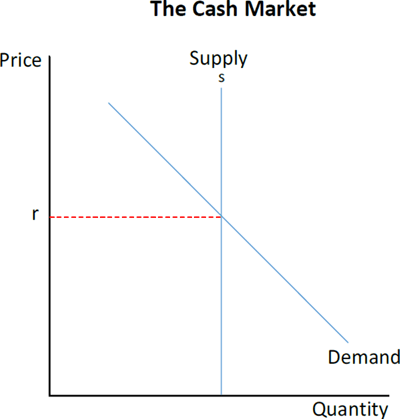
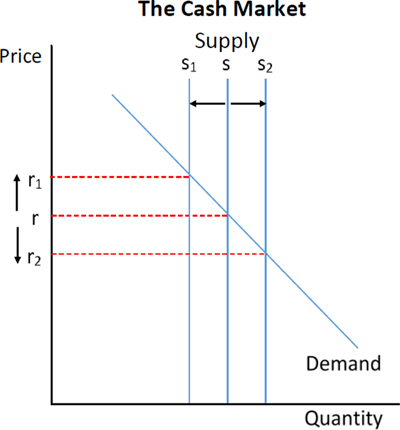
| Cash rate target (r) | Supply | Quantity | Price |
|---|---|---|---|
| Increase cash rate target | |||
| Central bank drains cash | ↓ | ↓ | ↑ |
| Decrease cash rate target | |||
| Central bank injects cash | ↑ | ↑ | ↓ |
|
Source: RBA |
|||
Typical textbook analysis shows that the shift of the supply curve for cash is achieved through OMOs. When the central bank sells bonds to banks and receives cash (in return for bonds), it reduces the supply of cash in the market. Conversely, when the central bank buys bonds from banks and provides cash (in return for the bonds), it increases the supply of cash in the market.
However, there are gaps in this analysis which are important for understanding how the RBA manages the cash rate in practice.
What actually happens?
Typical textbook analysis captures most aspects of the Australian cash market (price, quantity, demand and supply), but critically omits the role of the policy interest rate corridor.
What is the policy interest rate corridor and why is it important?
The policy interest rate corridor is defined by a floor and a ceiling around the cash rate target in the Australian cash market. The floor is the RBA's deposit rate, which is currently the cash rate less 0.1 percentage points on any excess ES balances banks deposit at the RBA. The ceiling is the RBA's lending rate, which is the cash rate plus 0.25 percentage points on any ES balances banks borrow if they need to cover shortfalls.[5]
Figure 3 provides a stylised model of the Australian cash market by including the policy interest rate corridor. Banks have no incentive to borrow at interest rates higher than the RBA's lending rate (the ceiling), so there are no transactions above the corridor. And they have no incentive to accept a deposit rate lower than the one the RBA offers (the floor) – so there are no transactions below the corridor. All market activity is contained within the corridor.
Furthermore, those banks that have excess ES balances are always willing to deposit their cash with other banks at a higher rate than the RBA's deposit rate (the floor of the corridor) to earn a higher return. At the same time, those that need to borrow in the Australian cash market seek a rate that is lower than the RBA's lending rate (the ceiling of the corridor). Consequently, the price of transactions has historically gravitated towards the cash rate target inside the corridor.
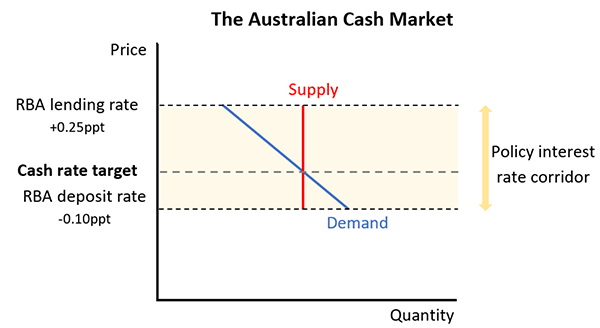
Demand in the cash market can and does move around. Before the COVID-19 recession, the RBA typically responded to any shift in demand for cash (ES balances) by managing the supply of cash. This ensured the cash rate remained consistent with the cash rate target. In other words, the RBA would attempt to manage liquidity to shift the supply curve so that it intersected the demand curve at the cash rate target. Figure 4 shows how the cash rate can be maintained at its target by responding to an increase in demand by increasing supply (with both curves shifting to the right). On the other hand, Figure 5 shows that to keep the cash rate at target, a decline in demand is responded to by reducing supply (with both curves shifting to the left).
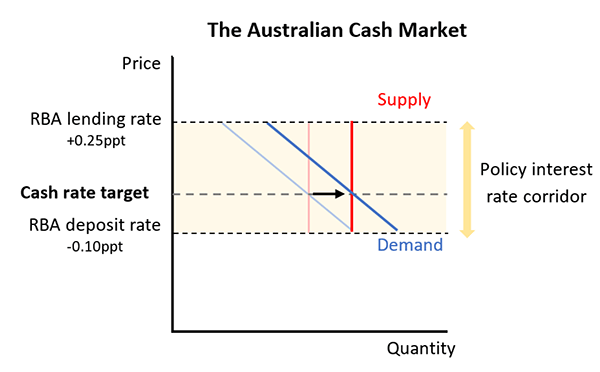
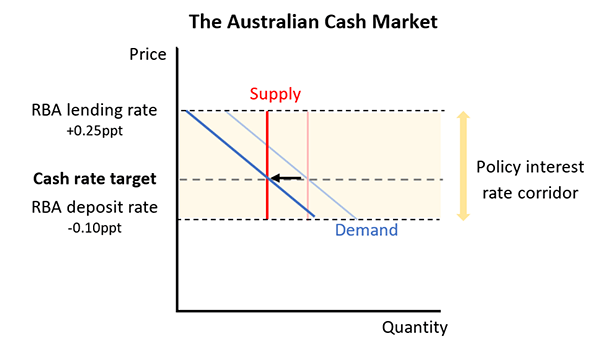
The important point is that in practice, before the COVID-19 recession, changing the supply of cash through OMOs had typically been done to keep the cash rate at target on a daily basis – not to change the target after a monetary policy decision.
So how is the cash rate target changed?
After the announcement by the Reserve Bank Board to change the target cash rate, the RBA resets the policy interest rate corridor around the new target cash rate. In essence, the existence of the policy interest rate corridor does all the work.
But how did this happen before the COVID-19 recession?
If the cash rate target was lowered as part of the monetary policy decision, the RBA's deposit rate and lending rate would be adjusted so that the entire policy interest rate corridor shifted lower (Figure 6). The incentives for banks to trade within the new corridor would remain, and transactions would gravitate to the middle of the corridor (the new cash rate target). This is because banks would want to borrow at rates lower than the RBA's lending rate (the ceiling) and make deposits at rates higher than the RBA's deposit rate (the floor). Because of this, the new cash rate target would be achieved without the need for the RBA to conduct any OMOs.
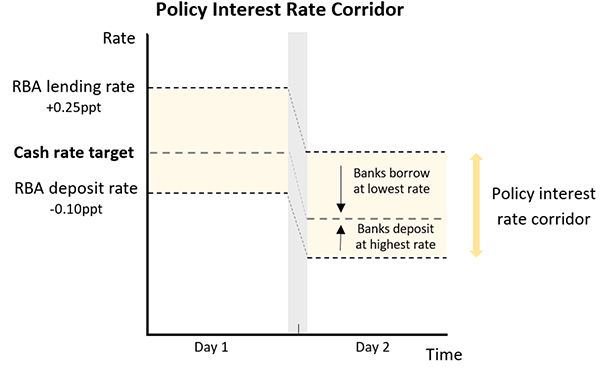
In practice, the market moved automatically, and immediately, to the new cash rate target. The process was reinforced by the RBA's credibility in managing the supply of cash in the market and has fostered a convention for almost all transactions to occur at the cash rate target. As shown in Graph 1, for most of the past two decades, there has been little deviation of the cash rate from its target.
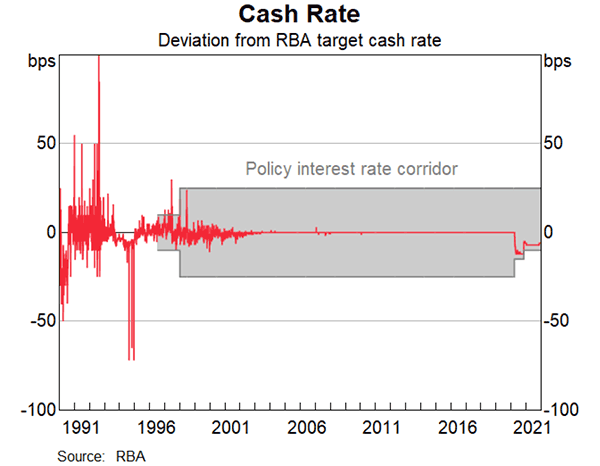
What happened after the onset of COVID-19?
Following the onset of COVID-19, the RBA began using unconventional monetary policy tools. This caused the supply of cash in the cash market to increase substantially, which caused the price in the Australian cash market (the cash rate) to fall below the target cash rate.
The impact of unconventional monetary policy tools on the cash market is depicted in the stylised diagram below (Figure 7). The cash market is originally at point A, where the demand and supply curves intersect at a cash rate equivalent to the cash rate target. When the RBA introduced unconventional monetary policy tools, such as the Term Funding Facility, the supply of ES balances in the cash market increased (shown as a rightward shift of the supply curve). The demand and supply curves now intersect at point B, with the cash rate below the cash rate target. The increase in the supply of ES balances has effectively meant that the cash rate is now near the floor of the corridor as opposed to being at the cash rate target.
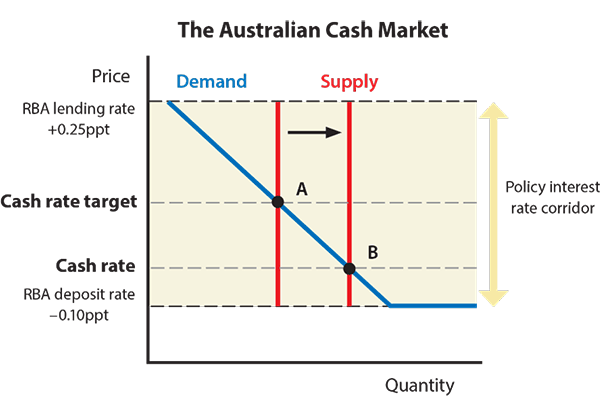
A Closer Look at Open Market Operations
Prior to the COVID-19 recession, OMOs were used to keep the cash rate at target on a daily basis.
Typical textbook analysis generally describes the central bank's OMOs as the direct buying and selling of government bonds. When the central bank buys bonds, it injects cash into the financial system (as banks' ES accounts are credited with cash in return for bonds)[6] When the central bank sells bonds, it withdraws cash from the financial system (as banks' ES accounts are debited to pay for bonds).
This process is correct. However, there is more to OMOs.
Prior to the COVID-19 recession, the RBA typically conducted OMOs on a daily basis. The RBA announced the value of cash it intended to inject into or withdraw from the financial system, the type of transaction and its duration as part of an auction process.
There are three types of transactions which the RBA typically conducts as part of its OMOs:
- Bond purchases or sales. The RBA buys or sells bonds in exchange for ES balances – cash. As a result, these transactions change the supply of cash in the market.
-
Repurchase agreements (Repos). The RBA uses repurchase agreements. A repo is a transaction that occurs in two parts. In the first part, the RBA lends a bond to a bank and receives ES balances (cash) in exchange, resulting in a decrease (drain) in the supply of ES balances on that day. In the pre-arranged second part, at an agreed price and date in the future, the RBA receives the bond back and returns the ES balances (cash) to the bank, resulting in an increase in the supply (injection) of ES balances on that day.
In the opposite case – commonly referred to as a ‘reverse repo’ – the RBA commences the transaction by borrowing a bond and providing ES balances (cash) to the bank, resulting in an increase in the supply (injection) of ES balances. The second leg of this transaction involves the RBA returning the bond to the bank and receiving ES balances (cash) back, resulting in a decrease (drain) in the supply of ES balances on that day. (See the comparison in Figure 8.)
- Foreign exchange swaps. The RBA also engages in foreign exchange swaps. A foreign exchange swap is similar to a repo. The main difference is that, instead of bonds, foreign currency (e.g. US dollars or Japanese yen) is used in the transaction.
Of the three types of transactions, reverse repos are the most commonly used by the RBA in their OMOs rather than outright purchases/sales of government bonds, as is commonly described by textbooks. This is because the RBA mostly injects cash into the market to cover ES balance shortfalls and their flexibility allows the RBA to manage liquidity on two separate days, using the one tool.[7] Repos give the RBA the flexibility to manage the supply of cash in the market (liquidity) and smooth the effects of large transactions between banks and the RBA or the government - such as tax and social welfare payments – that can have a material effect on the total amount of cash in the market (or ‘system liquidity’). To help manage liquidity, the RBA forecasts cash movements to inform its decisions about when to ‘unwind’ repos.
| Repo* | Reverse repo* |
|---|---|
First leg: RBA lends bonds out and
receives cash (drains)
|
First leg: RBA borrows bonds and provides cash (injects) |
Second leg: RBA receives bonds back and returns cash (injects) |
Second leg: RBA returns bonds and receives cash back (drains) |
|
* From the viewpoint of the RBA. Sell bonds with agreement to repurchase them at a future date, or buy bonds with a commitment to return them at a future date. Source: RBA |
|
Since the COVID-19 recession
The RBA's unconventional monetary policy measures have led to an increase in the supply of ES balances and the cash rate drifting below its target. Accordingly, the RBA currently does not conduct OMOs to keep the cash rate at its target level. Instead, OMOs are used to complement the other monetary policy measures introduced since the onset of the COVID-19 recession.[8] As a result, currently the RBA takes into account market conditions when considering when to conduct OMOs (rather than conducting OMOs on a daily basis).
Wrapping Up
The RBA's implementation of monetary policy is an area of confusion for professional economists, commentators and educators alike, particularly in reference to how closely the actual process aligns with the standard textbook explanations. The two main gaps in typical textbook explanations relate to:
- The omission of the policy interest rate corridor. The corridor is key to how the RBA implements monetary policy, particularly a change in monetary policy, as it encourages banks to trade ES balances at an interest rate within the corridor; prior to the COVID-19 recession, ES balances were traded at an interest rate consistent with the target cash rate.
- The use of open market operations. Textbooks often link OMOs with achieving a change in the cash rate. However, the RBA has typically used OMOs in the past to manage the supply of cash and keep the cash rate at its target on a daily basis.
In summary, prior to the pandemic, the market automatically traded at the new cash rate target following a change to monetary policy. This was achieved by the policy interest rate corridor, which reset around the new cash rate target, and banks having no incentive to trade outside of this corridor. OMOs were used by the RBA to manage the supply of cash (liquidity) in the market on a daily basis as part of its liquidity management practices. Since the onset of the COVID-19 recession, OMOs have largely been used to complement the RBA's other monetary policy tools.
This information can be viewed at a glance in the accompanying table ‘The Reality of Monetary Policy Implementation’.
Footnotes
The article was originally authored by Kellie Bellrose, building on the Explainer ‘How the Reserve Bank Implements Monetary Policy’, and drawing heavily on the Domestic Markets Bulletin article, ‘The Framework for Monetary Policy Implementation in Australia’ with guidance from Chris Becker. This resource has been updated by Joyce Tan to reflect the expanded suite of policy tools used during the COVID-19 recession, drawing on the RBA speech ‘Monetary Policy During COVID’ and assistance from the Domestic Markets department. [*]
Because the cash rate acts as a key reference rate, a change to the cash rate has a strong influence over other interest rates in the economy, such as deposit and lending rates for households and businesses. These changes to interest rates, in turn, affect economic activity and inflation. For more information, see the RBA's Explainer: The Transmission of Monetary Policy. [1]
OMOs involve the buying and selling of bonds each day in the ‘open market’ through a competitive auction process. [2]
ES balances are equivalent to cash being held on deposit with the RBA and are used by financial institutions to settle transactions between themselves, the RBA or its clients. [3]
The supply curve for cash is vertical because the central bank determines the level of ES balances and no one else is legally able to create such cash. In other words, the central bank is responsible for setting the total quantity of ES balances available to market participants, who then trade (or redistribute) this cash amongst themselves. [4]
In the past, the corridor around the cash rate was symmetric; that is the ceiling was 0.25 percentage points above the cash rate target and the floor was 0.25 percentage points below the cash rate target. [5]
In the bank accounts held at the RBA are the RBA's own electronic currency called ES balances (which is essentially like cash). Banks make payments between each other by debiting and crediting ES balances. For example, if Bank A wanted to pay Bank B, it would do this through ES balances – Bank A's account would be debited and Bank B's account would be credited. [6]
There is limited government debt on issue in Australia, making it difficult for the RBA to conduct liquidity management using outright transactions. As a result, there tends to be a reliance on repos and foreign exchange swaps. [7]
See the Domestic Markets Bulletin article ‘Recent Changes to the Reserve Bank's Liquidity Operations’ for more information. [8]